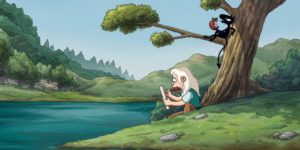Not Exactly Spell-Binding | Disenchantment Season 2
Disenchantment is an odd show. Not odd as in weird — though there are demons, fish ladies
and a place called TwinkleTown — but more in the sense that it sticks out. While its animated
comedy peers (Bojack Horseman, Rick and Morty, Big Mouth) pride themselves on being challenging and subversive, depicting complex character relationships and nigh-unsolvable social problems, Disenchantment has no such high-falutin’ ambitions. Problems are solved. Characters are straightforward. Some of them even learn lessons. This is a throwback to a simpler time for animated comedy, although whether or not it knows it’s a throwback is another question.
Disenchantment comes to us from Matt Groening, a man who needs no introduction. After making the best cartoon of the ‘90s with The Simpsons and the best cartoon of the ‘00s with Futurama, the only question was if his new show would see Groening rule the ‘10s as well. Needless to say, the weight of expectation was, and still is, a millstone around Disenchantment’s neck.
The story follows Bean, princess of Dreamland, her elf friend Elfo and personal demon Lucy. Bean shows no interest in the pampered life of royalty and spends her days and nights at the tavern getting drunk with the commoners, to the loud and unrelenting rage of her father, King Zog.
After the events of the first season, everyone in Dreamland turned to stone. While Zog goes semi-crazy being king to a town of sculptures, Bean takes refuge with her mother in the city of Maru. She’s met with a warm reception but quickly becomes suspicious of her mother’s motives for rescuing her. These motives may have something to do with a prophecy surrounding Bean herself.
Netflix must have thrown some serious money at Groening because this is a gorgeous show. While most American animated comedies are content with fairly flat visuals, the environments here are lovingly detailed, with the “camera” often pulled back just so we can soak them in.

However, the obvious talent in the visuals is hampered by a lack of cleverness in the writing. The second episode sees Bean go to Hell and while Hell looks impressive, its comedic potential is neutered by some surprisingly tame gags. There must be a funnier and smarter way of depicting eternal torment than a series of extendable boxing gloves.
This lack of cleverness plagues the whole show. The writing can be funny and the characters are fine but there’s a dullness to it, which is disappointing considering how razor sharp The Simpsons and Futurama were in their prime. It may be unfair to compare Disenchantment against its legendary siblings but it invites comparison, sporting a similar sense of humour and a few call-backs. It even uses the classic Groening art style, all goggle-eyes and monstrous overbites.
And while its sibling series started with fairly broad templates (suburban family, sci-fi), they added enough interesting characters, world-building and personality to transcend their genres and become something more. Disenchantment, on the other hand, seems more content to mock and mildly subvert the tropes of its fantasy template (the princess is a drunk, her best friend is a demon etc.) than truly craft its own world. Twenty episodes in, the show still feels undercooked, like everything has been sketched out but nothing’s been coloured in.
In spite of that, I don’t believe Disenchantment is a bad show. If you’re in the mood for something comfy and undemanding, you could do worse. And in a time when so many high-concept animated comedies are pushing the boundaries of the genre, maybe there’s nothing more subversive than playing it safe.

